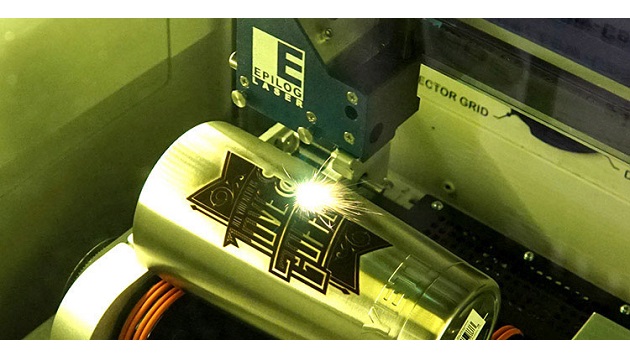Anti-fouling, ‘hydrophobic’ metal or plastic surfaces that imitate shark skins, engraved by a new laser technology being developed by European scientists, could soon replace the toxic varnishes used in ship coatings to stop algae or barnacles sticking to hulls – reducing maintenance costs, fuel bills and CO2 emissions.
Harnessing new photonics technology, a group of European scientists are currently developing a 1kw, ‘dot matrix’ ultrafast laser system that can carve flow-optimised metal or plastic surfaces capable of imitating the incredibly efficient skin from sharks.
Etching tiny ‘spike’ structures onto sheet metal or plastic, the new laser system can create a rough surface at a microscopic level. This uneven topography can create a reduction in drag or inhibit the growth of bacteria, algae or even barnacles.
Shark’s flesh, covered in millions of microscopic denticles – or tiny protruding scales – reduces drag to make it a highly efficient swimmer.
Similarly, engraved metal or plastic surfaces can have ‘anti-fouling’ properties that prevent contaminants or microorganisms from clinging on.
Funded by the Photonics PPP, the scientists behind the €4.7 million laser project hope that specially-designed structures on steel ship hulls could help to reduce fuel consumption and replace toxic ship paints and varnishes that are harmful to the environment.
Dr Johannes Finger, coordinator of the MultiFlex project, said: “Laser-fabricated surface structures have the potential to reduce friction and to prevent the growth of plants and algae. This could significantly reduce ship repair, maintenance, CO2 emissions and fuel bills while providing an alternative to harmful coatings that are toxic to the environment.”
“Besides maritime components, application fields can be found in aircraft and turbomachinery. Here, surface structures might inhibit cavitation and thus improve lifetimes of propellers of propulsion systems or water turbines.
“Our photonics system can also create design textures or ‘microcavities’. Here the environment benefits by replacing environmental problematic technologies like chemical etching,” said Dr Finger.
Ultrashort Pulsed (USP) or ‘Ultrafast’ lasers can ablate any material without damaging it. Surfaces cut with a USP are smooth, on a micron-scale and ideal for many industries where hard materials need to be processed with the highest precision.
Dot Matrix Laser
Developed by the MultiFlex project, the material is structured by the world’s first ‘dot matrix’ laser.
In the same way that an old-fashioned dot matrix printer uses a moving head, printing in a line by line motion, the laser sends super-fast pulses of concentrated energy to ablate – or cut – materials that are notoriously difficult to work with.
Resembling a giant chessboard, the system splits a single beam into a grid of 64 ‘beamlets’, where every single ray can be turned on, off, positioned, and individually ‘tuned’.
“Existing ultrafast lasers are known for their precise ablation and cutting results. Unfortunately, processing large parts with such lasers can take weeks. Our system will ablate more than 150 mm³ in one minute, therefore making it hundreds of times faster than existing technologies,” said Dr Finger.
Wider Applications
While the laser represents an exciting breakthrough in surface technology, the ultrafast laser has several wider applications:
Tool and Mould Manufacturing – With increased throughput, MultiFlex is making many USP mould and tool making applications, such as fabricating venting holes or microcavities, and making textures on free-form surfaces more cost-efficient. Tool and mould application is the first field where the technology will be validated.
Automotive – By delivering high throughput for USP surface processing technology, MultiFlex is tackling the micro-structuring applications for interior lighting, instrument clusters and aesthetic and haptic structures.
Electronics – Increasing the spread of ultrafast processing in electronics will improve the performance and reliability of sophisticated high-performance electronic components. Ultrafast laser-based fabrication of via holes and technical ceramics for high-performance electronics will be significantly improved.
Printing and Embossing – With a more economical and rapid production line, the MultiFlex system has the potential to significantly increase electronics printing, precise embossing of microstructures and the fabrication efficiency for high precision tools.
The consortium consists of the research institute Fraunhofer ILT and the Chair for Technology of Optical Systems of RWTH Aachen University from Germany as well as Amplitude Systèmes, LASEA France, AA OptoElectronic from France and LASEA from Belgium as industrial research and development partners.
For more information, visit: www.photonics21.org








